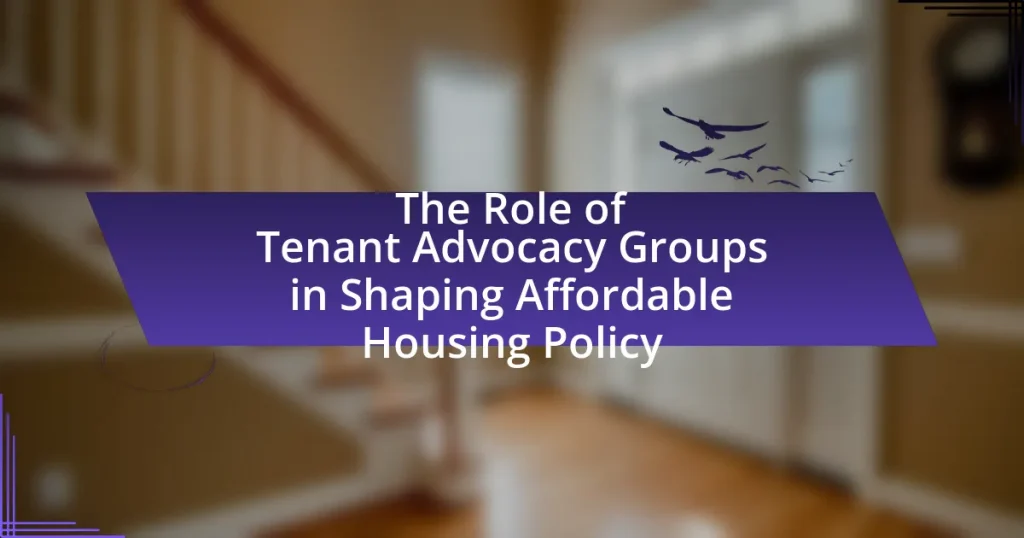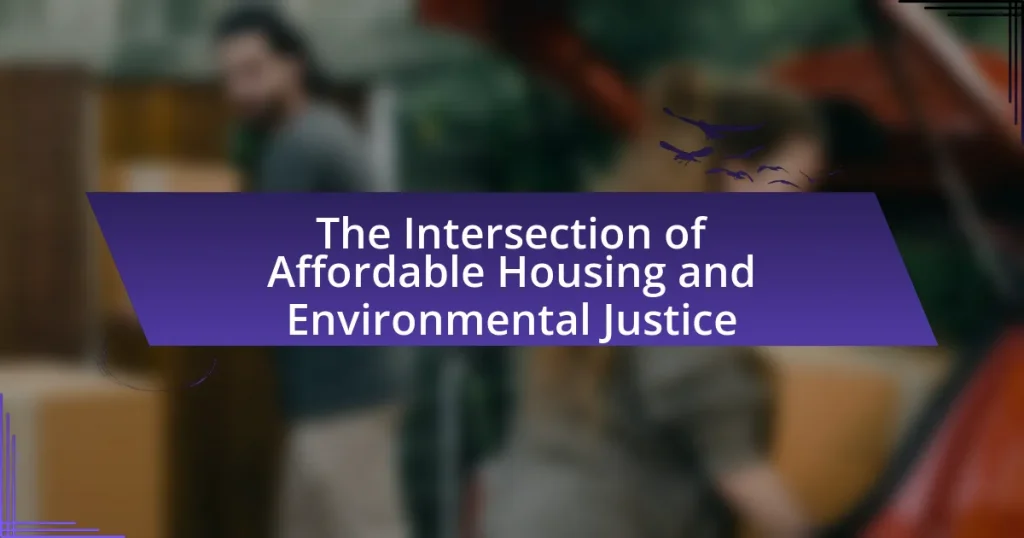The article focuses on strategies for increasing affordable housing access in urban areas, highlighting key approaches such as inclusionary zoning policies, enhanced public-private partnerships, and increased funding for affordable housing development. It examines the impact of zoning laws on housing availability and discusses potential modifications to promote affordability. The role of public funding, community engagement, and innovative design in addressing housing challenges is also explored, along with the influence of political dynamics and social factors on housing policies. Additionally, the article outlines best practices and successful examples from various cities, providing a comprehensive overview of effective methods to improve housing access for low-income residents.

What are the key strategies for increasing affordable housing access in urban areas?
Key strategies for increasing affordable housing access in urban areas include implementing inclusionary zoning policies, increasing funding for affordable housing development, and enhancing public-private partnerships. Inclusionary zoning mandates that a percentage of new developments be affordable for low-income residents, which has been successfully adopted in cities like San Francisco, resulting in thousands of affordable units. Increasing funding through government grants and subsidies can support the construction and preservation of affordable housing, as evidenced by the Low-Income Housing Tax Credit program, which has financed over 3 million affordable homes since its inception. Public-private partnerships leverage resources and expertise from both sectors, facilitating innovative housing solutions, as seen in initiatives like the Housing Trust Fund, which has generated significant investment in affordable housing projects.
How do zoning laws impact affordable housing availability?
Zoning laws significantly restrict affordable housing availability by limiting the types of housing that can be built in certain areas. These regulations often mandate minimum lot sizes, prohibit multi-family units, and impose strict design standards, which can drive up construction costs and reduce the overall supply of affordable housing options. For instance, a study by the National Multifamily Housing Council found that restrictive zoning contributes to a shortage of nearly 7 million affordable rental units in the United States. Consequently, such laws can exacerbate housing shortages and increase prices, making it difficult for low-income families to find suitable housing.
What changes can be made to zoning regulations to promote affordable housing?
Zoning regulations can be modified to promote affordable housing by allowing higher density developments, reducing minimum lot sizes, and permitting mixed-use zoning. Higher density developments enable more housing units to be built in a given area, which can lower costs through economies of scale. Reducing minimum lot sizes allows for smaller, more affordable homes to be constructed, making it easier for developers to create budget-friendly options. Mixed-use zoning encourages the integration of residential and commercial spaces, which can lead to more vibrant communities and lower transportation costs for residents. These changes have been supported by studies indicating that increased density and mixed-use developments can significantly enhance housing affordability in urban areas.
How do inclusionary zoning policies work in urban settings?
Inclusionary zoning policies require developers to include a certain percentage of affordable housing units in new residential developments. These policies aim to create mixed-income communities and increase the availability of affordable housing in urban areas. For example, cities like San Francisco and New York have implemented inclusionary zoning, mandating that 10-30% of units in new developments be affordable for low- to moderate-income households. This approach not only helps to address housing shortages but also promotes socioeconomic diversity within neighborhoods. Studies have shown that inclusionary zoning can lead to the creation of thousands of affordable units, making it a vital strategy for enhancing housing access in urban settings.
What role does public funding play in affordable housing initiatives?
Public funding is essential for affordable housing initiatives as it provides the necessary financial resources to develop, maintain, and subsidize housing projects. This funding often comes from government sources, including federal, state, and local budgets, which allocate funds specifically for affordable housing programs. For instance, the Low-Income Housing Tax Credit program has facilitated the creation of over 3 million affordable housing units since its inception in 1986, demonstrating the significant impact of public funding on housing availability. Additionally, public funding can help leverage private investment, making projects more viable and expanding the overall capacity to address housing shortages in urban areas.
How can government grants and subsidies be utilized effectively?
Government grants and subsidies can be utilized effectively by ensuring they are targeted towards specific housing needs and integrated into comprehensive urban development plans. Targeting grants to areas with the highest demand for affordable housing can maximize their impact; for instance, the Low-Income Housing Tax Credit program has successfully increased affordable housing units by incentivizing private investment in low-income areas. Additionally, integrating these financial resources with local zoning laws and community input can enhance their effectiveness, as seen in cities like San Francisco, where public-private partnerships have led to the development of thousands of affordable units. This strategic alignment not only addresses immediate housing shortages but also fosters sustainable urban growth.
What are the benefits of public-private partnerships in housing development?
Public-private partnerships in housing development enhance affordable housing access by leveraging resources, expertise, and risk-sharing between the public and private sectors. These collaborations can lead to increased funding for projects, as private entities often bring in capital that public agencies may lack. For instance, a study by the Urban Institute found that such partnerships can accelerate project timelines and reduce costs, making housing more accessible. Additionally, these partnerships can foster innovation in design and construction methods, improving the quality and sustainability of housing developments.
How can community engagement enhance affordable housing strategies?
Community engagement can enhance affordable housing strategies by fostering collaboration between residents, local governments, and developers, ensuring that housing solutions meet the actual needs of the community. Engaged communities can provide valuable insights into local preferences, identify specific housing challenges, and contribute to the design and implementation of affordable housing projects. For instance, a study by the Urban Institute found that community involvement in planning processes leads to more successful housing developments, as they are more likely to reflect the desires and requirements of the residents. This participatory approach not only increases the likelihood of project acceptance but also promotes long-term sustainability and community ownership of affordable housing initiatives.
What methods can be used to involve residents in housing planning?
Residents can be involved in housing planning through methods such as community workshops, surveys, participatory budgeting, and focus groups. Community workshops allow residents to express their needs and preferences directly, fostering collaboration between planners and the community. Surveys can gather quantitative data on resident opinions and priorities, ensuring that a broad range of voices is heard. Participatory budgeting empowers residents to allocate funds for specific housing projects, giving them a direct stake in the planning process. Focus groups facilitate in-depth discussions, allowing for nuanced feedback on housing proposals. These methods have been shown to enhance community engagement and lead to more effective housing solutions that reflect the needs of residents.
How does community feedback influence housing policy decisions?
Community feedback significantly influences housing policy decisions by providing policymakers with insights into the needs and preferences of residents. This feedback can shape the development of affordable housing initiatives, ensuring they align with community priorities. For instance, studies have shown that when local governments actively solicit input from residents through surveys and public meetings, they are more likely to implement policies that reflect the community’s desires, such as mixed-income developments or zoning changes that facilitate affordable housing construction. Additionally, community feedback can lead to increased public support for housing projects, as residents feel their voices are heard and considered in the decision-making process.

What are the challenges faced in implementing affordable housing strategies?
The challenges faced in implementing affordable housing strategies include funding limitations, regulatory hurdles, and community opposition. Funding limitations arise from insufficient public and private investment, which restricts the ability to develop and maintain affordable housing units. Regulatory hurdles often involve complex zoning laws and building codes that can delay projects and increase costs. Community opposition, frequently referred to as NIMBYism (Not In My Backyard), can hinder the approval of new developments, as local residents may resist changes that they perceive as detrimental to their neighborhoods. These factors collectively impede the effectiveness of affordable housing initiatives, making it difficult to meet the growing demand for accessible housing in urban areas.
Why do financial constraints hinder affordable housing projects?
Financial constraints hinder affordable housing projects primarily due to limited funding availability and high construction costs. These financial limitations restrict developers’ ability to invest in necessary infrastructure, materials, and labor, ultimately leading to fewer affordable units being built. For instance, a report from the National Low Income Housing Coalition indicates that in many urban areas, the cost of land and construction has risen significantly, outpacing wage growth and making it difficult for developers to create housing that remains affordable for low-income families. Additionally, the lack of access to low-interest loans and grants further exacerbates the issue, as developers often rely on these financial resources to subsidize costs and ensure project viability.
What are the common funding sources for affordable housing?
Common funding sources for affordable housing include federal and state government programs, private investments, and nonprofit organizations. Federal programs such as the Low-Income Housing Tax Credit (LIHTC) provide tax incentives to developers, while state housing finance agencies often offer grants and loans to support affordable housing projects. Additionally, private investments from banks and real estate firms contribute capital, and nonprofit organizations frequently engage in fundraising and partnerships to finance housing initiatives. These funding sources collectively play a crucial role in addressing the affordable housing crisis in urban areas.
How can financial barriers be overcome in urban areas?
Financial barriers in urban areas can be overcome through targeted policy interventions, such as increasing access to affordable housing financing options. Programs like low-income housing tax credits and down payment assistance initiatives have been shown to enhance affordability for low- and moderate-income families. For instance, the National Low Income Housing Coalition reports that states utilizing these tax credits have seen a significant increase in the availability of affordable units, thereby reducing financial strain on residents. Additionally, implementing inclusionary zoning policies can require developers to allocate a percentage of new housing units as affordable, further addressing financial barriers.
What social factors affect the success of affordable housing initiatives?
Social factors that affect the success of affordable housing initiatives include community engagement, socioeconomic status, and local government support. Community engagement ensures that the needs and preferences of residents are considered, leading to higher acceptance and utilization of housing projects. Socioeconomic status influences demand for affordable housing, as lower-income populations are more likely to benefit from such initiatives. Local government support, including policies and funding, is crucial for the implementation and sustainability of affordable housing projects. Studies show that areas with strong community involvement and supportive policies see greater success in affordable housing outcomes, as evidenced by the National Low Income Housing Coalition’s report highlighting the correlation between community advocacy and housing stability.
How does gentrification impact affordable housing access?
Gentrification significantly reduces access to affordable housing by increasing property values and rental prices in urban neighborhoods. As wealthier individuals move into these areas, demand for housing rises, leading to higher costs that often displace long-term residents who can no longer afford to live there. For example, a study by the National Community Reinvestment Coalition found that neighborhoods experiencing gentrification saw a 30% increase in rental prices, making it difficult for low-income families to secure housing. This dynamic creates a cycle where affordable housing options diminish, exacerbating socioeconomic disparities and limiting access for vulnerable populations.
What demographic trends should be considered in housing strategies?
Housing strategies should consider trends such as urbanization, aging populations, and increasing diversity. Urbanization is significant, with over 55% of the global population living in urban areas as of 2020, projected to rise to 68% by 2050, necessitating housing solutions that accommodate growing city populations. The aging population trend indicates that by 2030, one in six people globally will be over the age of 60, requiring accessible and affordable housing options tailored to seniors. Additionally, increasing diversity, with minority groups projected to make up 57% of the U.S. population by 2060, highlights the need for culturally sensitive housing strategies that reflect the needs of various communities. These demographic trends are critical for developing effective housing policies that ensure equitable access to affordable housing in urban settings.
How do political dynamics influence affordable housing policies?
Political dynamics significantly influence affordable housing policies by shaping legislative priorities, funding allocations, and community engagement strategies. Political parties and their ideologies often determine the extent to which affordable housing is prioritized; for instance, progressive administrations may advocate for increased funding and regulatory support for affordable housing initiatives, while conservative administrations may focus on market-driven solutions. Additionally, local political coalitions can mobilize community support or opposition, impacting policy outcomes. Historical examples include the 1960s Great Society programs, which expanded federal support for affordable housing, and the more recent push for inclusionary zoning laws in urban areas, driven by local political advocacy. These dynamics illustrate how political contexts directly affect the formulation and implementation of housing policies.
What role do local governments play in housing accessibility?
Local governments play a crucial role in housing accessibility by implementing policies and regulations that promote affordable housing development. They influence zoning laws, which determine land use and can facilitate or hinder the construction of affordable housing units. For instance, local governments can adopt inclusionary zoning policies that require developers to include a percentage of affordable units in new housing projects. Additionally, they can provide financial incentives, such as tax credits or grants, to encourage the development of affordable housing. According to the National Low Income Housing Coalition, local governments are responsible for nearly 80% of the decisions affecting housing development, highlighting their significant impact on housing accessibility.
How can advocacy groups affect housing legislation?
Advocacy groups can significantly affect housing legislation by mobilizing public support, influencing policymakers, and providing research-based evidence to highlight housing issues. These organizations often engage in grassroots campaigns, lobbying efforts, and public awareness initiatives that draw attention to the need for affordable housing. For instance, the National Low Income Housing Coalition has successfully advocated for increased funding for housing programs, demonstrating that organized efforts can lead to legislative changes. Additionally, advocacy groups often collaborate with local governments and stakeholders to draft and promote policies that address housing shortages, thereby shaping the legislative landscape in favor of affordable housing initiatives.

What best practices can be adopted for effective affordable housing strategies?
Effective affordable housing strategies can be adopted by implementing inclusionary zoning, which requires developers to allocate a percentage of new housing units for low-income residents. This practice has been shown to increase the availability of affordable housing without significant public expenditure. For instance, cities like San Francisco and New York have successfully utilized inclusionary zoning to create thousands of affordable units, demonstrating its effectiveness in urban areas. Additionally, leveraging public-private partnerships can enhance funding and resources for affordable housing projects, as seen in successful initiatives across various metropolitan regions.
How can innovative design contribute to affordable housing solutions?
Innovative design can significantly contribute to affordable housing solutions by optimizing space, reducing construction costs, and enhancing energy efficiency. For instance, modular construction techniques allow for faster assembly and lower labor costs, which can decrease overall housing expenses. Additionally, the use of sustainable materials and energy-efficient designs can lead to long-term savings on utility bills, making housing more affordable for residents. Research from the Harvard Joint Center for Housing Studies indicates that innovative design approaches can reduce construction costs by up to 20%, thereby increasing the feasibility of affordable housing projects in urban areas.
What are the benefits of modular and prefabricated housing?
Modular and prefabricated housing offers significant benefits, including reduced construction time, cost efficiency, and sustainability. These housing solutions can be built in a factory setting, which allows for faster assembly on-site, often cutting construction time by 30-50% compared to traditional methods. Cost efficiency arises from streamlined production processes and reduced labor costs, making housing more affordable. Additionally, modular homes often utilize sustainable materials and energy-efficient designs, contributing to lower environmental impact. According to a study by the National Institute of Standards and Technology, modular construction can reduce waste by up to 90% compared to conventional building methods, further supporting the sustainability claim.
How can sustainable building practices reduce costs?
Sustainable building practices can reduce costs by minimizing energy consumption and lowering operational expenses. For instance, energy-efficient designs and materials can lead to significant savings on utility bills; studies show that buildings designed with sustainability in mind can reduce energy costs by up to 30%. Additionally, using sustainable materials often results in lower maintenance costs over time, as these materials tend to be more durable and require less frequent replacement. Furthermore, sustainable practices can qualify projects for tax incentives and grants, further decreasing initial investment costs. Overall, the integration of sustainable building practices not only enhances affordability but also promotes long-term financial savings for urban housing projects.
What lessons can be learned from successful affordable housing programs?
Successful affordable housing programs demonstrate the importance of community involvement in planning and implementation. Engaging local residents ensures that the housing meets their needs and fosters a sense of ownership, which can lead to better maintenance and community cohesion. For instance, the San Francisco Mayor’s Office of Housing and Community Development emphasizes participatory design processes, resulting in projects that reflect the community’s preferences and priorities. Additionally, successful programs often utilize mixed-income models, which promote economic diversity and reduce stigma associated with affordable housing. Research from the Urban Institute shows that mixed-income developments can enhance social integration and improve outcomes for low-income residents. Furthermore, effective partnerships between government, non-profits, and private developers are crucial, as seen in the success of the Low-Income Housing Tax Credit program, which has financed over 3 million affordable housing units since its inception in 1986. These lessons highlight the need for collaboration, community engagement, and diverse funding strategies in creating sustainable affordable housing solutions.
Which cities have implemented effective affordable housing strategies?
Cities that have implemented effective affordable housing strategies include Vienna, Austria; San Francisco, California; and Singapore. Vienna’s model emphasizes social housing, with over 60% of residents living in subsidized units, showcasing a long-term commitment to affordability. San Francisco has introduced inclusionary zoning laws requiring developers to allocate a percentage of new housing for low-income residents, addressing the city’s housing crisis. Singapore’s Housing and Development Board has successfully provided affordable public housing to over 80% of its population, demonstrating a comprehensive approach to urban housing needs. These examples illustrate diverse strategies that effectively increase affordable housing access in urban areas.
What metrics should be used to evaluate the success of housing initiatives?
To evaluate the success of housing initiatives, key metrics include affordability, occupancy rates, and resident satisfaction. Affordability can be measured by the percentage of income spent on housing, with successful initiatives typically aiming for costs below 30% of a household’s income. Occupancy rates indicate the effectiveness of housing initiatives in filling available units, with higher rates suggesting successful demand fulfillment. Resident satisfaction can be assessed through surveys that gauge quality of life, safety, and community engagement, providing insights into the initiative’s impact on residents’ well-being. These metrics collectively offer a comprehensive view of the effectiveness and impact of housing initiatives in urban areas.
What practical steps can communities take to improve housing access?
Communities can improve housing access by implementing inclusive zoning policies that promote affordable housing development. These policies can require a percentage of new developments to be designated as affordable units, thereby increasing the overall supply of accessible housing. For instance, cities like San Francisco have adopted inclusionary zoning, resulting in thousands of affordable units being created. Additionally, communities can establish land trusts to acquire and manage land for affordable housing, ensuring long-term affordability and stability. Research shows that community land trusts can effectively reduce housing costs and prevent displacement, as evidenced by successful models in Burlington, Vermont. Furthermore, local governments can streamline permitting processes to reduce barriers for affordable housing projects, which has been shown to expedite development timelines and lower costs.
How can local organizations collaborate to enhance housing efforts?
Local organizations can collaborate to enhance housing efforts by forming partnerships that leverage resources, share expertise, and coordinate services. For instance, housing nonprofits can work with local governments to align policies and funding initiatives, while community development organizations can engage with private sector stakeholders to create mixed-income housing projects. Evidence of successful collaboration can be seen in initiatives like the “Housing First” model, which has been implemented in various cities, leading to a significant reduction in homelessness rates by providing stable housing as a primary focus. This approach demonstrates that coordinated efforts among local organizations can effectively address housing challenges and improve access to affordable housing in urban areas.
What resources are available for communities seeking to increase affordable housing?
Communities seeking to increase affordable housing can access various resources, including federal programs, state initiatives, and local partnerships. The U.S. Department of Housing and Urban Development (HUD) offers funding through programs like the Community Development Block Grant (CDBG) and the HOME Investment Partnerships Program, which provide financial assistance for affordable housing development. Additionally, state housing finance agencies often administer low-income housing tax credits (LIHTC) that incentivize private investment in affordable housing projects. Local governments can also collaborate with non-profit organizations and community development corporations to leverage resources and expertise in housing development. These resources collectively support the creation and preservation of affordable housing options in urban areas.



